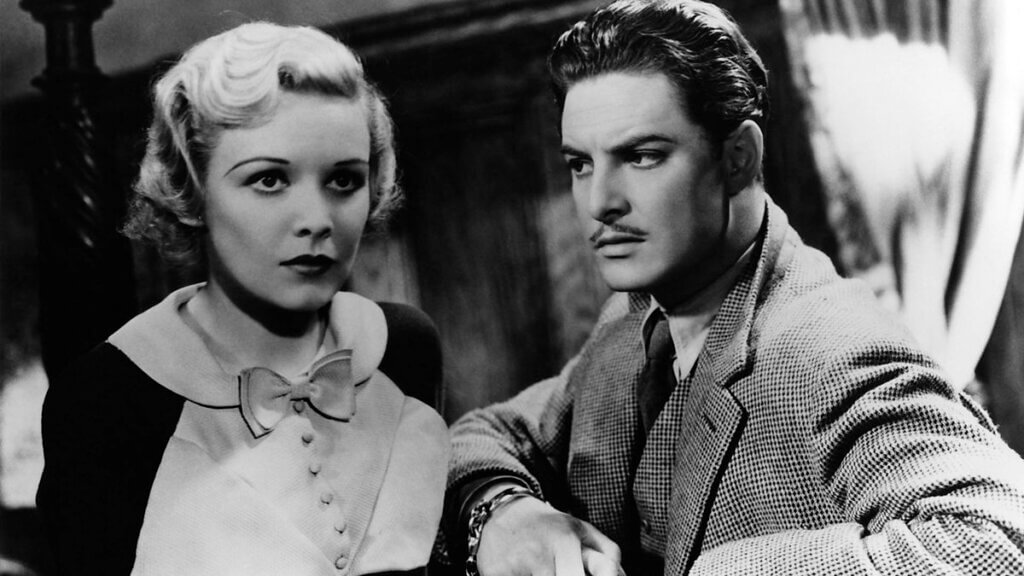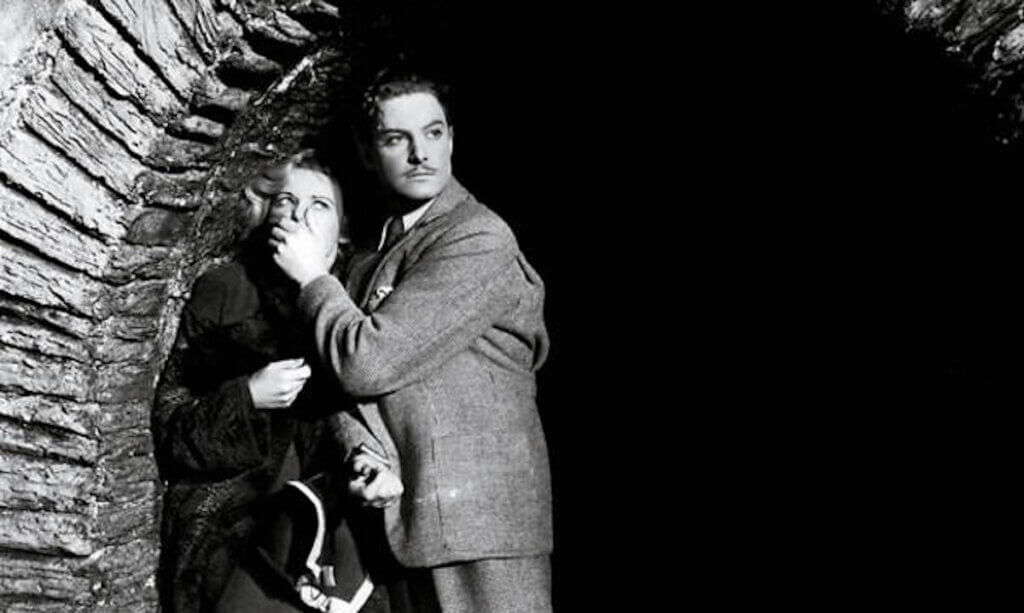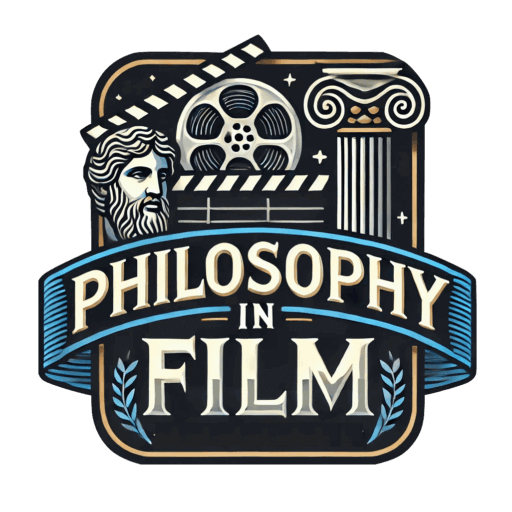Mixing Genres and Political Turmoil in The 39 Steps
Though Hollywood has dominated the global film industry since the 1910’s, many influential directors and films have surfaced outside of the United States. In the mid-1930’s, a studio system very similar to Hollywood (albeit smaller) formed in Great Britain. During this period of increased production and organization within the industry, Alfred Hitchcock emerged as one of the most popular and influential directors. Hitchcock established himself as a prominent director of silent films in the 1920’s, but he truly found his niche with the onset of the sound era. In terms of genre, Hitchcock became best known for directing thrillers. In a New York Times film review of The 39 Steps, columnist Andre Sennwald describes Hitchcock as “a master of shock and suspense, of cold horror and incongruous wit” (Sennwald).
However, these same films often had moments of lighter tone, typically seen through romance and comedy. The 39 Steps is a perfect example of Hitchcock’s ability to mix genres. The story begins as a spy thriller, and though this plot continues throughout the film, it also evolves into a screwball comedy. The blending of these two genres has obvious entertainment value, but it also serves as a reflection of the political and social tension of Great Britain in the 1930’s. With the rise to power of the Nazi Party in 1933, fears of political turmoil and war swept across Europe. In Britain, there was an increased “fear of traitors and spies [that] gained expression in drama, film and comics (Miller 317). This paranoia and social unrest were popularized in film, particularly in Hitchcock’s thrillers. The Man Who Knew Too Much (1934), The 39 Steps (1935), and The Lady Vanishes (1938) all played on the concept of foreign spies involved in international conspiracies. Hitchcock meshes the thriller and screwball comedy genres in The 39 Steps to feed into the paranoia about political turmoil in Europe, while also appealing to the desire for light, escapist entertainment.
The 39 Steps is a perfect example of a Hitchcock thriller. The thriller genre, at its most basic form, is stylistically characterized by the precise withholding and revealing of information to the audience, which creates a sense of tension and mystery. Toby Miller describes the thriller as a story of “accidental discovery” in which “mystery lands in the lap of a bright young man who proceeds to solve it and save his country from a conspiracy” (Miller 323). Miller also argues that as the thriller genre developed, it began to focus on “the identification and defeat of wrongdoers through participation and exploration, a practical reasoning that ultimately explained irregular, undesirable events” (Miller 321).
The 39 Steps exemplifies this definition. In the film, Richard Hannay stumbles backwards into an international conspiracy that he must unravel to save himself, Great Britain, and possibly the world. The film begins at a rambunctious music hall in London, where a sudden gunshot causes a panic, forcing Hannay into the arms of a strange woman. He soon discovers that she is a spy and is responsible for the shooting. She tells Hannay that there are two spies trying to kill her, and that she must intercept a piece of information that is vital to British national security before it leaves the country. Hannay is skeptical, but when he discovers that the mysterious woman has been stabbed in the back, he sets off on a journey to retrieve the top-secret information and clear his name in the process. This type of thriller, in which a man is falsely accused of a crime and must prove his innocence, became a staple of Alfred Hitchcock’s film career.

In contrast to the thriller genre, the screwball comedy is traditionally defined as a love story between a man and a woman, with comedic situations that arise from this love, and a happy resolution. For Britain in the 1930’s, much of the appeal of this genre could be attributed to its escapist undertones. In most screwball comedies, realism is essentially absent, while comedy and romantic love are at the forefront of the plot. Though the formula for screwball comedies may seem realistic on the surface because it focuses on people in real-life situations, the scenarios for these films usually do not represent reality. This connection between apparent “reality” and fiction allows audiences to escape reality without necessarily being conscious of the film’s absurdly fictional premise. The 39 Steps presents itself as a screwball comedy in several ways, although most of the characteristics of the genre are non-existent until about halfway through the film. For example, Hannay and Pamela get handcuffed together and are forced to escape the assassins as a team. While this situation is theoretically possible, it is a rather absurd scenario, and yet it is vital for the comedic and romantic elements of the plot.
» You Might Like: Responsibility and Victimization in Grave of the Fireflies
Later, after escaping from the handcuffs, Pamela attempts to sneak away while Hannay sleeps. As she sneaks out of the bedroom, she overhears the assassins talking and discovers that Hannay is innocent of the murder and has been telling the truth the whole time. Soft, romantic music begins to play as she returns to their room, and her expression and body language make it clear that she is now attracted to Hannay. This sudden change is very unrealistic considering her previous dislike for Hannay, but this change allows the tension and comedy to shift to romance, fulfilling the essential elements of a screwball comedy.
In this genre, the plot often revolves around a “battle of the sexes” set within the world of the upper class. Hannay seems to be a well-off, educated man with the financial means to travel, and Pamela serves as his counterpart in this “battle” between men and women. Pamela is introduced as a seemingly random passenger on the train that Hannay is taking to Scotland. Hannay bursts into her compartment to avoid the police and passionately kisses her so the investigators will pass him by. Though this is technically the beginning of their comical love affair, Pamela chooses to blow his cover and, for the moment, the plot continues without her. Their story really begins during his empowering speech at a political rally, where Pamela recognizes him as the criminal from the train. After his speech, the two spies capture Hannay as he pleads for Pamela to believe his story. Realizing that she knows too much, the spies bring her along under the pretense of being a witness against Hannay.
At this point, Hannay and Pamela are forced to fight with one another because they are handcuffed together and have two very different outlooks on the situation. Hannay wants to clear his name and escape the assassins, while Pamela doesn’t show interest in Hannay’s fate and mostly just wants to be left alone. Though this is a comical “battle” between the two, there is also a literal and figurative connection between them. Miller states that “the focus on male-female relations happens again when Hannay and Pamela are handcuffed together…this unwelcome bracketing becomes a sign of their transformation into a couple, the ‘concrete object’ of the cuffs expressing a ‘concrete relation’” (Miller 326). Their close proximity forces Hannay and Pamela to have comical fights, despite their budding romance.
The 39 Steps uses these two genres, the thriller and the screwball comedy, to reflect two opposing approaches to the social and political turmoil in Europe. Even at the time of its release, critics note that “Hitchcock describes the remarkable chain of events in Hannay’s flight across England and Scotland with a blend of unexpected comedy and breathless terror that is strikingly effective” (Sennwald). The spy thriller aspect of the film brings the reality of European politics directly to the audience, albeit in a subtle, entertaining fashion, while the screwball comedy aspects of the film allow the audience to escape from the same negative sociopolitical atmosphere that is indirectly addressed in the plot of the film.

This may seem counterintuitive, but Hitchcock seamlessly transitions between the two genres and makes both aspects of the film entertaining. Hannay himself helps represent the meshing of both genres in several ways. Miller describes Hannay as a “depthless character typical of spy-genre protagonists”, which is emphasized when Hannay himself declares that he is “’nobody’” (Miller 326). Miller also identifies the appearance of both genres by identifying Hannay’s ability to blend in when he “proceeds to be a milkman, a mechanic, a parade marcher, a politician and a criminal, the perfectly depthless figure who can be anyone…yet at the same time, this sets up the conditions of possibility for comedy, as a series of misunderstandings produce chaos, then a happy resolution” (Miller 327).
While the film does allude to the political tension in Europe, Hitchcock is careful not to be too specific with certain elements of the plot. If actual political parties or movements had been mentioned specifically (i.e. the Nazi Party, fascism, etc.), the film would have created a much more realistic tone and might have hit a little too close to home with British audiences. However, by only referring to international conspiracies and spy stories, Hitchcock references real-life politics without directly mentioning the turmoil in Europe. Miller states that The 39 Steps “embodied prevailing issues of its day to do with class, race, gende,r and national security. It made especially powerful arguments for the value of the Dominions to Britain in a hostile world…it pointed to the danger of mass frenzy” (Miller 319). Hitchcock also comments on this concept of “mass frenzy” and distrust of the public through staging and location.
Whenever a scene in the film is set within a controlled public area, it quickly devolves into chaos and violence. In the beginning scene at the music hall, a brawl begins for no apparent reason, followed by a gunshot and further panic. Later in the film, Hannay’s rousing speech at the political rally causes a great surge of people onto the stage. At the end of the film, Mr. Memory is shot during his performance, causing people to rush from the theater in a panic. Miller states that “the crowd was a figure of great anxiety in early twentieth-century public policy…for behind every public tumult of mass energy lies one more group of agitators ready to displace existing rulers with their own power-mongering” (Miller 324). The paranoia concerning international conspiracies led to a general distrust of the public, and Hitchcock emphasizes this distrust with specific staging and location.
The 39 Steps is a very entertaining film, and it works very effectively as a thriller and a screwball comedy. Hitchcock plays on the fears of the British public with a story about international conspiracies, but also allows audiences to escape from reality with comedy and romance. The looming shadow of Nazi Germany created paranoia concerning the safety of British citizens, and this paranoia led to a distrust of the public.
Regarding this paranoia, Miller quotes novelist Wesley K. Wark in stating that “the enemy could be the Jew, the foreigner, the not-quite gentleman, the corrupted, the bomb-throwers, the women. Why the day needed to be saved was very much a product of national insecurities” (Miller 320). In the film, the assassins serve as the enemy that causes these insecurities, while Hannay serves as the falsely accused. The love story, while not a necessary catalyst for the conspiracy plot, diverts attention away from the gravity of world politics. Hitchcock used a spy story and a comical love affair to seamlessly blend the thriller and screwball comedy genres in The 39 Steps.
Miller, Toby. “39 Steps to the ‘Borders of the Possible’: Alfred Hitchcock, Amateur Observer and the New Cultural History.” Alfred Hitchcock: Centenary Essays.
Editor: Richard Allen. London: British Film Institute, 1999. 318-328. Sennwald, Andre. “The 39 Steps.” The New York Times Review. 1935. The New York Times. April 23, 2011. <http://movies.nytimes.com/movie/review>
For more film essays, consult the Philosophy in Film Homepage!

